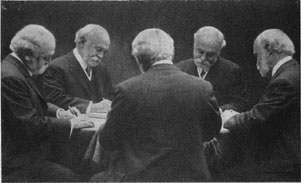A little teaser for the next Special Delivery, although actually, this is the image from the second one that I mentioned. It’s linked to the entire page.
Category: Special Delivery
We pause in our mobile blogging frenzy to present some biographical information regarding Jarvis A. Wood. They say you should find your niche and stick with it; possibly this is mine. Someone asked, by the by, if I knew who the businessman mentioned in regards to the Sherman Act in Special Delivery 2. I don’t know, but I’ll see what I can dig up.
The following excerpts are from The History of an Advertising Agency, Ralph M. Hower, Harvard University Press, 1949:
p. 79:
In 1888, Ayer took on his staff Jarvis A. Wood, a young man with a gift of ready words, who immediately began to devote much of his time to writing advertisements for Ayer customers.
p. 98-99:
In January, 1898, a step was taken that reduced the burden upon Ayer and McKinney, and promoted a more equable distribution of managerial duties. Two employes of the firm, Jarvis A. Wood and Albert G. Bradford, were advanced to partnership.
Wood had started to work for N. W. Ayer & Son in 1888 as assistant to F. W. Ayer. Genial, friendly, and gifted with a ready flow of words, he was expected to follow Mckinney as the agency’s leading business getter and producer of advertising ideas. His talents, however, lay in other directions. For a number of years he supervised the preparation of copy; his business associates believe that he was the first man to head an agency copy department. Later he was made manager of the large staff of employees and placed in charge of the general routine work of the Philadelphia organization. In that capacity his tact, his fatherly manner, and his complete loyalty enabled Wood to serve the agency well.
In addition to lightening the burden upon the two senior partners, the admission of Bradford and Wood represented the attempt to provide for a continuity of management. It is significant that these two had not been brought in from the outside. Both had been employed in the agency for more than ten years and knew every phase of the work. Like Wallace and Mckinney, neither of then contributed any new capital to the business; each paid for his share out of earnings received after admission to the partnership. Their promotion, like every promotion to top management in N. W. Ayer & Son before or since, was based not on financial interest but on their ability, promise, and experience within the firm, a fact which has given Ayer employees an incentive to put forth their best efforts.
After the admission of the new partners, the responsibilities of the business were divided as follows: McKinney was in charge, as before, of the business getting activities: Bradford handled the buying of space and other dealings with publishers; and Ayer, with Wood as his assistant, exercised a close supervision over operations as a whole.
p. 125:
It is worth noting that none of them could be regarded as a specialist in space buying, and that since the death of Jarvis Wood, there was no member of the firm whose specialty had been the preparation of copy.
This one opens with a picture of Jarvis Wood, along with Jarvis Wood, Jarvis Wood, Jarvis Wood, and Jarvis Wood. They’re gathered around a table working on this issue of Special Delivery. Apparently, photographic trickery is not a new thing. Multiple exposure? Something like that.
(Did you miss the first entry? Read this.)
“The entire editoral staff of the Special Delivery wishes the holder of this copy a Merry Christmas in the good year nineteen thirteen.
“Jarvis A. Wood (signed)
“The Wesley Inn
Wayne, Pennsylvania
Christmastide, nineteen thirteen”
Turn the page.
This Christmas, my mother gave my brother and I complete sets of something that my great-great-grandfather (my maternal grandfather’s maternal grandfather), Jarvis A. Wood, wrote every Christmas for the last several years of his life.
They’re little booklets in ivory covers, about half the size of a mass market paperback and perhaps forty pages thick. The words “Special Delivery” are embossed on the front, along with hashmarks in later years to mark the volume number.
The first one, which I’m looking at right now, is printed in red and green — mostly green, with lovely use of spot color. Inside the front cover there’s a little sketch of a tag, inscribed “Tag! You’re it!” It’s also signed, by hand, “Uncle J.” Turn the page, and there’s the title page in front of you. A photograph of the author is glued to the left hand page.
If you’ll allow me the liberty, I’d like to share some of his writing with you. I find myself struck by his eloquence, and his turn of phrase. He was a minister, and worked in advertising, so perhaps his skill with the word is not entirely surprising. The year is 1912; it’s Christmas. Turn the page again.
